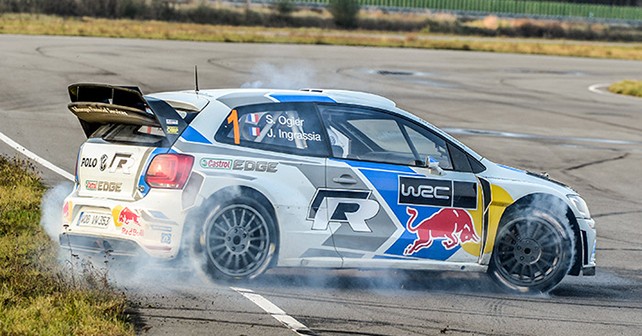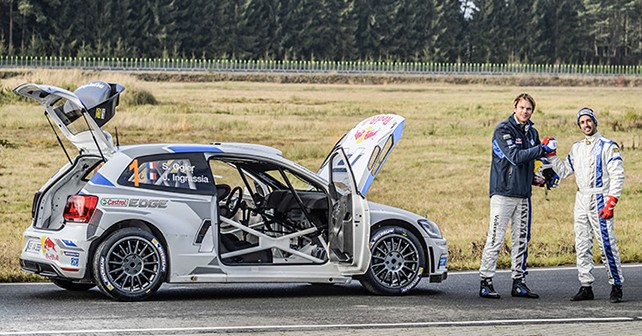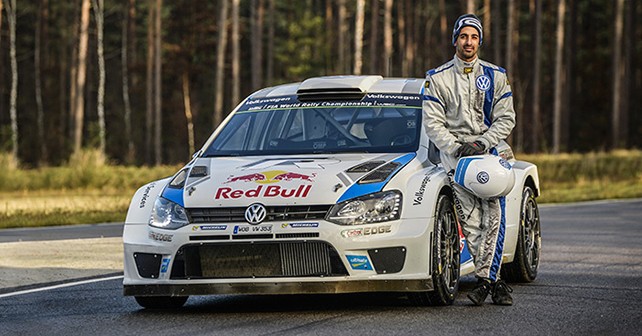We travel three days for a three-minute drive in a 2-time championship winning World Rally Car. Yes, we drive a World Rally Car! Correction, spin a World Rally Car. Oh dear…
It’s been well over a decade since I last whiled away an evening playing Colin McRae Rally on the Play Station – although Nicky Grist’s voice is still echoing in my ears. Now I’m not certain if that qualifies as experience in a World Rally Car, but I am certain of the fact that in no way did it prepare me for this…
Nor did my first rally car, which was a 1996 Maruti Esteem that proceeded to fall apart a few kilometres into the first stage of my first rally – the Delhi round of the INRC (Indian National Rally Championship) in 2004. I had better luck in my Gypsy, which saw me through (sometimes successfully) several Raid-de-Himalayas and a Desert Storm. But, really, a Gypsy is a little more than a horse-cart on wheels. To get it to steer (or slide) around a bend, you have to plead with it and wrestle it at the same time. I suppose my experience in the Bowler EXR a few months ago was better preparation, but even that couldn’t have readied me for the ferocity of this machine!

When the call came from the good folks at Volkswagen, I thought Christmas had come early. It went something like this: “Would you like to travel to VW’s top-secret test centre at Ehra-Lessien to test the Polo R WRC car?” My response: “Do children like candy? Do dogs like bones? Do politicians crave power?” In short, yes!
The only thing that I can think of that could top that would be the chance to pilot a Group B Audi Quattro or Lancia 037. But those are rather priceless, and hairy I would imagine – so I would be fearful of exceeding 40km/h. In a current WRC Polo however, I would have the blessings of the factory to push it to the limit – well, to my limit anyway. And since a new car is being homologated for next year, it’s the last chance to drive this historic machine – which saw VW enter the WRC and dominate right away. In fact, I was at the Sweden Rally last year, which was their first win – in just their second full WRC event. At the time, Sebastian Ogier and Jari-Matti Latvala were leading the charge. But now they have a third driver as well – 25-year-old Norwegian, Andreas Mikkelsen.

His tryst with rallying took place on an ice-lake where a small course had been set up. After a few days of practise, he was getting pretty proficient. So someone rang the then Norwegian national rally champion, who was kind enough to pay a visit – only to be embarrassed by a young Andreas who was quicker than him. Needless to say, that was the start of his interest in rallying. Already, after just his first full year in WRC, he’s just a few tenths of a second per kilometre behind his two far more experienced – and illustrious – teammates. In order to make up for his lack of experience, he plans to spend the winter studying thousands of hours of on-board footage with the help of a Norwegian memory expert.

Most of you will remember Ehra as the track where James May set a record with the Bugatti Veryon. That’s one of the few glimpses the outside world has gotten of VW’s top-secret test track. We, of course, weren’t using the 20 kilometre main track – with its 8.7 kilometre straight. Instead, we would be using a 1.8 kilometre tarmac stage buried somewhere in the bowels of this massive facility. This is where VW Motorsport does a shakedown before each rally – just to make sure that everything’s in working order before shipping out for a world championship event. We even had a few security personnel in high visibility jackets tailing us to ensure that we didn’t accidentally wander off and discover some deep, dark secrets – you’d think they were hiding Elvis in there.
Fortunately, the track we were assigned to had plenty of run-off – so it would be difficult to cause lasting damage. Less encouraging was the weather. It was freezing, literally, and the tarmac was soaked. Fortunately, before we were let loose in the Polo R WRC machine, we got one lap each tailing Andreas in a road-going Golf GTD. The course was tight, tricky and very slippery – even the Golf was having trouble putting its power down. After that, we did a passenger lap in the Golf with Andreas at the wheel, so he could talk us around a lap. There were undulations and blind corners – very much like a proper rally special stage. There was one corner in particular however – an off-camber right – that Andreas warned us about. A warning that I would have been wise to heed!

But before we got to experience the drive of a lifetime, we had to learn a little bit about the car itself. Fortunately, Richard Browne, Andreas’ race engineer, was on hand to give us a full run through. Let’s start with the engine, which is a high-pressure direct-injection 1.6 litre turbocharged four-pot. It’s built by VW at their engine factory not far away from this test centre. The FIA mandates a 33-millimetre air restrictor that’s intended to restrict horsepower to 300bhp. VW claims 315, although I have a sneaking suspicion it’s a bit more than that. Without the restrictor, it has the potential to produce twice as much – and it does in its rallycross avatar.
Exact power ratings aside, the FIA runs a pretty tight ship. All the teams run the same restrictor, same turbo, same tyres, and have to conform to a minimum weight of 1,200kgs. So, the chassis makes all the difference. Looking at the engine, frankly, doesn’t reveal very much. It’s nicely banked – although even the maximum angle is restricted by the FIA – so it’s positioned low in the chassis and set as far back as possible. The FIA has a control unit that monitors rpm (limited to 8,500), boost pressure (limited to 2.5 bar), and injection pressure (limited to 200 bar). Traction control isn’t permitted either, so front and rear wheel speeds are monitored as well. Four-wheel drive is a given, and so is a sequential six-speed racing gearbox. The bit that borders on black magic, though, is the anti-lag technology. It is simply astounding, and it’s a real shame that it would melt the turbo in your regular road car – because it rocks! And we were running the anti-lag in its mildest setting – allegedly to suit the conditions, but more likely because four non-professionals were about to strap into the drivers seat. Sure, there was limited racing experience between us – Romain, for instance, has even been on the podium of a Lamborghini Super Trofeo race – but we were clearly very wet behind the ears when it came to driving WRC machines. Let’s be clear, these are the fastest machines on the planet in which to cover terrain varying from snow to tarmac, and everything in between.

Finally, we get to the end of the lap and I’m given the go-ahead. I quickly thumb the button marked ‘Stage,’ and the digital display ahead of me changes instantly – now showing me just revs and gears. Clearly, I’m on a need to know basis. The engine has a different map for road sections – remember, transport stages take place on public roads – and a different map for competitive sections. The difference is, well, stark! Like Andreas said, “When you hit stage mode, it becomes a monster.” Jesus, he wasn’t kidding. If, in ‘Road’ mode it felt distantly related to a regular Polo, in ‘Stage’ mode it felt closer in lineage to a Lamborghini Aventador.
We were running a full tarmac setup, and with the 18-inch rims, the response from the steering was incredible. The steering rack and gearing – which stay the same throughout the year – seem perfectly suited to this track. This car must be completely insane to drive on dirt – well, even more insane than this that is. The steering rack feels like it’s been lifted from a Ferrari 458 – it’s that precise and quick. It feels like you would need just half-a-lock for a hairpin bend – well, that and a bit of handbrake I suppose. The gear lever, meanwhile, falls perfectly to hand. One piece of advice from Richard before we set off was to be as aggressive with the gear lever as possible – even if we wanted to be merciful to the machine. Plus, Andreas looked like he worked out, so I was giving it everything with each gear change. The trouble was that the engine was revving so fast that I simply couldn’t keep up – and this is with anti-lag as its mildest! I hit the limiter more than once, before I got accustomed to the velocity with which the revs climb. It revs like nothing else I’ve ever experienced. Flat spots – what are those? 315bhp and 425Nm – those are just numbers, this thing feels like it produces twice that.
I felt like I was shifting all the time, not merely because it has short gearing but purely because the power delivery is savage. The pedals are perfectly weighted – the brake pedal in particular was brilliant. The brakes themselves felt like they were from another planet. You can brake so late and carry so much speed into corners – famous last words…
Warm-up lap complete, so I started to push a bit more. I was finally coming to terms with the power delivery, and was trying to feel for the grip levels. I still remember the first time I drove a 30 horsepower go-kart – which continues to feel like one of fastest things I’ve ever driven. It took a few corners for my brain to adapt to the signals being transmitted by my eyes, conveying the pace at which we were covering distance. Only this time I didn’t have the luxury of time to adapt. I had to figure out which way the road was going, what gear I ought to be in, and how much speed I could carry before my two laps were up. Typically, I prefer to get into a rhythm and gradually build the speed – so it wasn’t ideal. But if it sounds like I’m complaining – I was driving a ‘World Rally Car’ – I’m not. Even in my wildest dreams, I wouldn’t have imagined this. And so I just got on with the job at hand. The next lap was quicker. The car was planted, despite the conditions. It cornered completely flat – there wasn’t even the slightest bit of flex or roll in the structure whatsoever. The term scalpel sharp has never seemed so appropriate before. The turn-in was truly incredible. And it seemed forgiving too.

On my second lap, as I came up to the very corner that Andreas had warned us about – the tight, blind, off-camber right hander – I attempted to carry too much speed through the corner and quickly myself found rotating all the way around. I remember it like it happened a second ago. It was following a straight – well a curved straight – in which I got up to about 6,500rpm in 6th. Hard braking and downshift to 4th for a relatively straight-forward left-hander, a dab on the throttle before braking and downshifting again to 3rd for the (now, infamous) right-hander, in which the road drops away from you. Since it was my second lap – meaning, it was my final minute at speed in a World Rally Car – I was too eager. Too greedy! And I simply carried too much speed into the corner. Before I knew it, I was on full opposite-lock. There was a glimmer of hope, as I felt I could hold it. I thought the diffs would work in my favour, but the angle was too much. I had to get off the throttle completely, and it came all the way around very unceremoniously indeed. I knew I had blown it. At least, I was still on the tarmac and hadn’t beached it in the middle of the field – thank god for small mercies. And while I did put the clutch in, it did stall.
I got it restarted however, and set off in search for a place to turn around. But I needed to find reverse for that. As I attempted to override the safety switch and put it in reverse, I realised that I couldn’t do it. The only thing I could do was wait to be rescued. I felt like a beached whale. Suffice to say, it was pretty humiliating. Well, at least one very-very expensive WRC machine was still in good knick. Like I said, be thankful for small mercies. And so, just 3 minutes and 15 seconds after I had been released from behind the camera car, my first (and hopefully not last) encounter with a world rally car had come to an end.
The trouble is, once you’ve tasted blood there’s simply no going back. You don’t give a man-eating tiger celery do you? And driving one of these really is like going over to the dark side. The performance envelope is truly from a parallel universe. It steers, stops and goes like a Veryon, but it’s the size and shape of a Polo – if that’s not black magic, then what is?
I – unceremoniously, once again – made my way back to the pits, and attempted to rationalize my exuberance (like I’ve done through the length of this piece). Fortunately, the entire VW crew were extremely kind, understanding and supportive. Andreas took me out for a passenger ride afterwards – just to properly put me in my place – and that was an astoundingly eye-opening experience. You think of rally drivers as covering large distances at about eight or nine-tenths. But these guys simply leave nothing on table at this level. It’s completely flat-out all the time. It’s brutal. It’s so competitive that VW doesn’t even allow Andreas to carry his own phone in the car because it’ll add weight. This taxi ride with Andreas properly reveals the limits of this incredible machine – not to mention the skill of a world rally driver. He’s smooth when he needs to be, and completely ragged when it’ll help him to manhandle an extra tenth of a second though a corner.
After the session, our times are revealed. Andreas did a 1:14.0. Romain did 1:19.6. Fernando did a 1:20.4. Ben did 1:20.5, and I managed to match that time – so all was not lost. They improved about two seconds on their second lap on average, so I was looking good – right up to the point when I decided to practise a surprise pirouette instead. Before I start with ‘what if,’ and ‘if only,’ I ought to end by saying that the whole experience completely blew me away. Would I travel another three days for three minutes in the drivers’ seat? Anytime.
I can only request VW not to dwell on my telemetry too much, and keep my number handy in case any one of their three drivers feels a little under the weather before an upcoming championship round in 2015. I’ll be there in a heartbeat. No complaints or excuses, and I promise not to spin. Really, I do…



- VW Polo R WRC
Fuel: Petrol
Transmission: 6-speed sequential racing gearbox / Permanent All-Wheel Drive
Power: 315bhp @ 6,250rpm
Torque: 425Nm @ 5,000rpm
Also read - Volkswagen Polo 1.0 TSI Review: First Drive



































Write your Comment